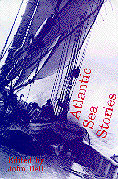


|
Atlantic Sea Stories.
Edited by John Bell.
Lawrencetown Beach, NS: Pottersfield Press, 1995. 222pp, paper,
$15.95.
ISBN: 0-919001-91-2. CIP.
Grades 9 and Up / Ages 14 - Adult.
Review by Joan Payzant.
****/4
|
excerpt:
``Men," the skipper bawled, when the crew had huddled amidships, cowering
from the wind, ``The ship'll strike the Blueblack inside o' thirty
minutes. 'Tis every man for his life."
The old man was up on the port-rail with the snow curling about him.
He had a grip of the mainmast shrouds to stay himself against the wind
and the lunging of the ship. The thud and swish of waves falling back and
the din of grinding ice broke from the depths of the snow over the bow --
from some place near and hidden -- and the gale was roaring past. The men
crowded closer to hear him.
``'Tis time t' take t' the ice," he cried.
In his introduction to Atlantic Sea Stories, editor John
Bell explains the thirty years from 1900 to 1930 were ``the golden age of
the Atlantic sea story." From that golden age he has selected ten
Atlantic authors who mainly wrote tales of the sea and sailing ships.
These years covered a time when fiction in periodicals was extremely
popular, and could be found in magazines such as McClure's, Ainslee's,
Blackwood's, Adventure, Putnam's, The Canadian Magazine, and The
Newfoundland Magazine.
In order of their appearance in Atlantic Sea Stories, the authors
are: Norman Duncan, W. Albert Hickman, Theodore Goodridge Roberts,
Wilfred T. Grenfell, Colin McKay, Frederick William Wallace, Erle R.
Spencer, Frank Parker Day, Archibald MacMechan, and Arthur Hunt Chute.
During their lifetimes most of these men had experienced life at
sea, either as crew members or passengers on sailing ships. Several were
journalists, all of them wrote books -- novels, collections of sea
stories, autobiographies, or non-fiction works about maritime life.
Atlantic Sea Stories has a wide range of style and
subject matter. For instance, the excerpt above tells of a sealing ship,
caught in a rushing ice floe, and headed for a rocky promontory with all
hands on board. Another concerns a sailing ship swamped by a water spout.
Two humorous stories lighten what might have been an overload of tragedy.
One of these is an hilarious tale of a race in Northumberland Strait
between a millionaire's yacht and a ship hastily fitted up with Rube
Goldberg-like propulsion machinery (reminiscent of Guy Gilpatric's
``Tugboat Annie"). There's a pirate story, a rum-running story, a press
gang story, and a true account of a first mate whose ship foundered,
leaving him adrift and alone.
The overall impression conveyed is of a world far removed from
today's maritime scene. Men worked unstintingly, courageously, to make a
living, but on an ocean still rich in fish. Electronic navigational aids
were unavailable, but skippers and crew were skilled in the art of
seamanship. Catch quotas were unknown, but on the other hand, so was
unemployment insurance.
Young people reading these stories today will be exposed to a
different way of life as seen through the writing of ten remarkable
authors who caught the experiences, character, and language of Atlantic
mariners living in the first thirty years of the twentieth century.
Highly recommended.
Joan Payzant is a retired teacher/librarian living in Dartmouth, N.S.
To comment on this title or this review, send mail to cmeditor@mts.net.

Copyright © 1996 the Manitoba Library Association.
Reproduction for personal use is permitted only if this copyright notice
is maintained. Any other reproduction is prohibited without permission.
Published by
The Manitoba Library Association
ISSN 1201-9364

CONTENTS FOR THIS ISSUE |
WELCOME


![]()

![]()
![]()